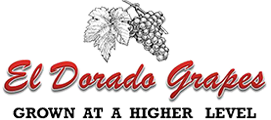Smoke Taint Resources for Growers By Lynn Wunderlich, UCCE Central Sierra Farm Advisor
This copy is from an email Lynn originally sent on Thursday, August 19, to subscribers of her blog. We share it here as important educational information.
Foothill grape growers and industry,
My thoughts and prayers go out to everyone as we navigate the Caldor fire. My home is on the edge of an evacuation warning zone so I’m with all of you in using my time primarily to pack and be prepared to leave if needed, and feeling pretty exhausted. I know many of you are already evacuated, and I’m hoping your homes, pets and family remain safe.
My purpose for this email is to provide you links and resources for investigating possible smoke taint in your fruit should you need this information-as I’ve been asked about this from several growers.
What is most important are people, so I bring you this information only as a service for those who are lucky enough to have smoke taint as their main concern. I wish I had something happier to share!
Anita Oberholster, our UCCE Enology Specialist, gave a presentation last year during a webinar on smoke taint sponsored by CAWG. I plan to invite her to share her latest research during my winter meeting.
Smoke Taint in Grapes:
Smoke taint appears dependent on the “freshness” of the smoke. If you are proximal to smoke/fire, you may experience taint in your fruit.
How does smoke taint a wine? When lignin, found in woody plants, is burned, volatile phenols (VPs) are released that absorb to grapevine leaves and berries. The VPs are absorbed through the berry skin and become BOUND inside. Australians have shown even pea sized green berries can become tainted.
Important here: there are both FREE and BOUND volatile phenols in grapes affected from smoke exposure. Bound are only detected when they are released during fermentation.
To analyze for volatile phenols (bound and free), recommendations are:
- Must sample berries close to harvest AND do micro-fermentations of fruit to predict smoke taint in finished wine.
- VPs: free guaiacol and 4-methylguaiacol but also o, p, m-cresol, syringol, and 4-methylsyringol
- These compounds are also naturally occurring in grapes (Syrah higher)
- Generally, white wines with taint show it more; and less complex reds with taint show it more.
- In addition to analysis of fruit and microfermentations, sensory evaluation is also recommended, especially if there is a “grey area”.
Our UCD Viticulture and Enology Specialist, Anita Oberholster, has done some research. Here is a good overview: https://wineserver.ucdavis.edu/industry-info/viticulture-resources/wildfire-impact-ca-grapes
Videos of wine/grape smoke taint research-Andrew Mimh’s “Wine matrix effects on taint”: https://video.ucdavis.edu/media/VEN290+-+Wine+matrix+effects+on+smoke+taint+expression/1_7i11v27r/164627702
Resources from the Australian Wine Institute:
Microfermentation method for small lots: https://www.awri.com.au/wp-content/uploads/small_lot_fermentation_method.pdf
Practical options for management: https://www.awri.com.au/wp-content/uploads/2012/04/smoke-taint-practical-management-options.pdf
TESTING. There are seven FREE VP compounds available for testing in berries and six BOUND VP precursors.
Check your winery contract to see what tests for smoke taint are specified. If you do not have an agreement with your winery, it is strongly recommended that you contact them and make one-down to the tests and even the lab and numbers that may be used to reject your fruit.
Berry samples (300 berries) should be done close to harvest.
Micro-fermentations, to test for BOUND VPs, need more time, about 2 weeks prior to planned harvest, in order to make and process.
UC doesn’t endorse any particular lab (I can’t tell you who is the best or most economical). I did a quick google search and found the following:
ETS laboratories: https://www.etslabs.com/library/2
Ellipse Analytics: https://www.ellipseanalytics.com/?gclid=EAIaIQobChMI34b38IW-8gIVmz2tBh2-kQ3MEAAYASAAEgKXlvD_BwE
Twin Arbor labs: https://www.twinarborlabs.com/smoke-taint-analysis-of-wine
I wrote a blog on this last year: https://ucanr.edu/blogs/blogcore/postdetail.cfm?postnum=43644
